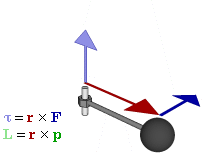I have read that it's not necessary for angular momentum and angular velocity to be parallel, but it is necessary for linear momentum and linear velocity to be parallel. How is this correct?
[Physics] Why are angular mometum and angular velocity not necessarily parallel, but linear momentum and linear velocity are always parallel
angular momentumangular velocitynewtonian-mechanicsrotational-dynamicsvectors
Related Question
- [Physics] Need help with relationship between angular momentum, linear and angular velocity
- Rotational Dynamics – Exploring Differences Between Directions of Angular Momentum and Angular Velocity
- Angular Momentum – How Can Angular Momentum Not Be Parallel with Angular Velocity?
- [Physics] Angular momentum and angular velocity


Best Answer
Note that this answer, like the tags of the question, is only focusing on Newtonian mechanics.
The definition of linear momentum $\mathbf p$ is expressed in terms of the linear velocity $\mathbf v$ using $$\mathbf p=m\mathbf v$$ Since $m$ is just a scalar quantity, the vectors $\mathbf p$ and $\mathbf v$ are obviously parallel. i.e. $$p_x=mv_x$$ $$p_y=mv_y$$ $$p_z=mv_z$$
However, the angular momentum $\mathbf L$ is related to the angular velocity $\boldsymbol \omega$ by $$\mathbf L=\mathbf I\boldsymbol\omega$$
where $\mathbf I$ is the moment of inertia tensor. This is explicitly written out as
$$ \begin{bmatrix} L_x\\L_y\\L_z \end{bmatrix}= \begin{bmatrix} I_{xx}&I_{xy}&I_{xz}\\ I_{yx}&I_{yy}&I_{yz}\\ I_{zx}&I_{zy}&I_{zz} \end{bmatrix} \begin{bmatrix} \omega_x\\\omega_y\\\omega_z \end{bmatrix} $$ Or each component written out: $$L_x=I_{xx}\omega_x+I_{xy}\omega_y+I_{xz}\omega_z$$ $$L_y=I_{yx}\omega_x+I_{yy}\omega_y+I_{yz}\omega_z$$ $$L_z=I_{zx}\omega_x+I_{zy}\omega_y+I_{zz}\omega_z$$
This shows that, in general, $\mathbf L$ and $\boldsymbol\omega$ are not parallel. We have something more complicated than the linear case because each component of the angular momentum vector depends on all of the angular velocity components.
However, this complexity does not prevent our two vectors from being parallel. We can determine when they are parallel by looking at the equation $$\mathbf L=\mathbf I\boldsymbol\omega=I\boldsymbol\omega$$ where $I$ is a scalar quantity. What this means is that $\boldsymbol\omega$ needs to be an eigenvector of $\mathbf I$ in order for $\mathbf L$ and $\boldsymbol\omega$ to be parallel. Note that this is usually what you encounter in your introductory physics classes. You, without knowing it, pick axes in such a way that the moment of inertia tensor is diagonal and your angular velocity is only along a single eigenvector (usually taken to be along the z-axis). For example, for a cylinder of radius $R$, height $H$, and mass $M$ rotating about its central axis aligned with the z-axis, we have $$ \begin{bmatrix} L_x\\L_y\\L_z \end{bmatrix}= \begin{bmatrix} \frac{1}{12}M\left(3R^2+H^2\right)&0&0\\ 0&\frac{1}{12}M\left(3R^2+H^2\right)&0\\ 0&0&\frac12MR^2 \end{bmatrix} \begin{bmatrix} 0\\0\\\omega_z \end{bmatrix} $$ Therefore we end up with the simple $$\mathbf L=L_z\hat z=I_{zz}\omega_z\hat z=\frac12MR^2\omega_z\hat z$$ or you might even see in an introductory physics class just $$L=\frac12MR^2\omega$$
As a small note, the reason things become so much more complicated with the rotations is that the angular momentum not only depends on the mass of the object, but also how that mass is distributed. This is evident from the definition of angular momentum for a point particle $\mathbf L=\mathbf r\times\mathbf p$
However, if we look at an extended body's momentum we just get $$\mathbf p_T=m_T\mathbf v_{\text{com}}$$ where the $T$ subscript stands for "total" and $\text {com}$ is center of mass. Therefore, we still end up with a scalar mass instead of a tensor.